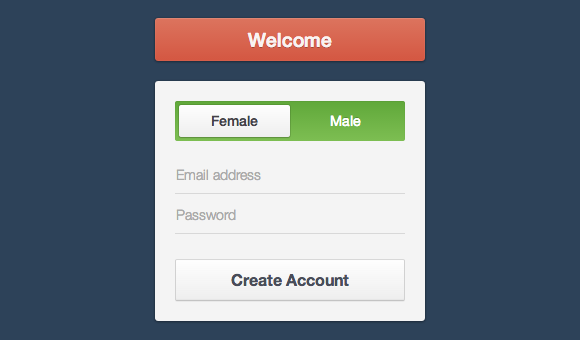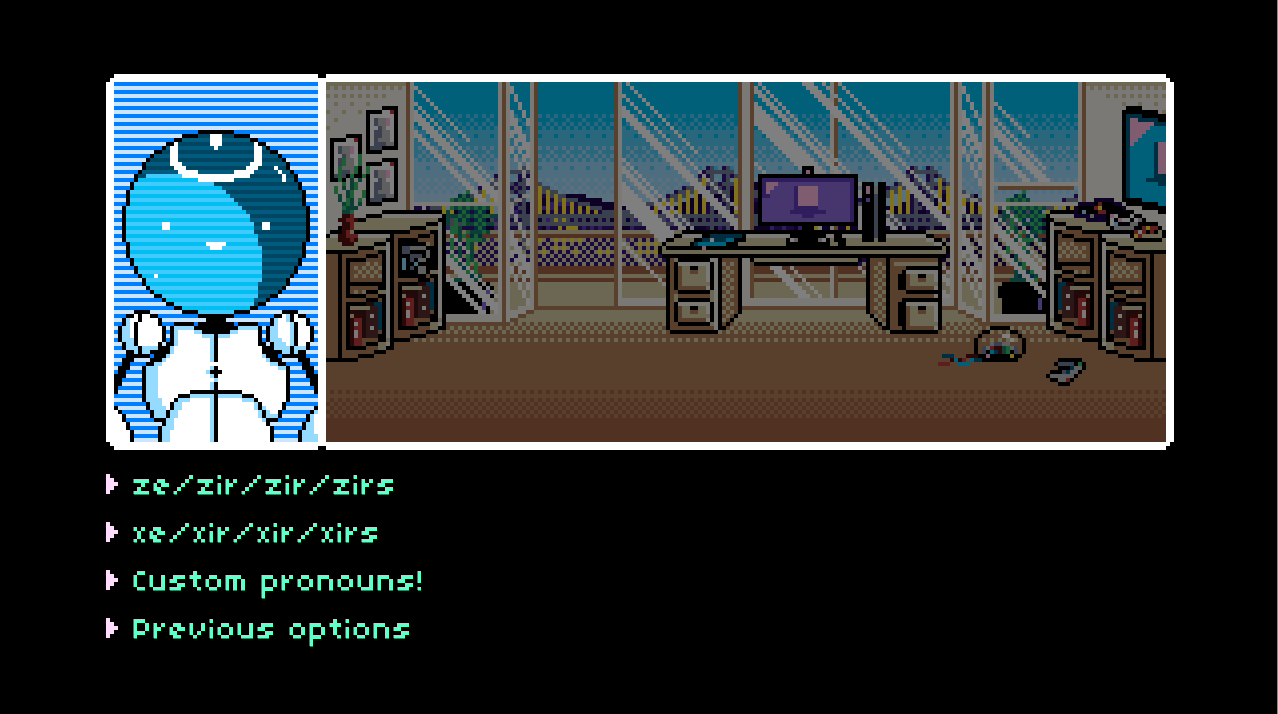Gender accessibility in user interfaces

Many of the user interfaces we interact with daily ask us questions about ourselves (or, in the case of videogames, they might ask about a character we are playing or creating). Questions about sex and/or gender seem like the equivalent of paperwork small talk—forms, surveys, and character creation systems often ask these questions without really needing or caring about the answers at all.
Even when a user or character’s gender is actually needed, the questions used to acquire this information are often constructed in a way that excludes whole groups of people. Excluding potential users of your game, site, survey, or whatever else by poorly asking a potentially unnecessary question is silly! So stick around, and learn something about gender accessibility in user interfaces.
Sex? Gender? What am I even asking?
Good question.
Sex and gender are two different things, but they are often confused and conflated. In simplest terms, biological sex is determined through a person’s physical features, while their gender identity is determined through their social and cultural features. Wikipedia has a fairly detailed entry on the distinction between sex and gender, which is updated regularly by the wonders of decentralised collaborative writing.
Sex is often divided into male and female, while gender is often divided into man and woman. People commonly think of both sex and gender as binary, although neither truly are. In terms of sex, not everyone has clearly defined, binary biological sex characteristics; people who are born with nonbinary physical characteristics are known as ‘intersex’. Gender has even more categories: outside of men and women, there are hundreds of other gender identities that people use every day, and the number is growing all the time.
And sex and gender aren’t the only categories that confuse people! There are other bits and pieces that can be difficult to get your head around. Like how is gender identity differentiated from gender expression? How are sex and gender different to concepts like sexuality, and how is sexuality split into things like sexual and romantic attraction?
I like to refer people to The Genderbread Person (by It’s Pronounced Metrosexual) when asked questions like these. It gives a quick visual summary of the differences between these different aspects of identity.

Thoughts on the genderbread person →
If you are using a screenreader, please click here to access a full description of The Genderbread Person.
There’s a lot to consider in regards to sex / gender / sexuality. None of these traits exist as binaries, and they aren’t as easy to ask about as many people seem to think.
So, where does this leave you?
Well, first, it’s important to understand what you are trying to find out from your users and why you are trying to determine it.
Do I really need to know?
Often, people ask about gender because it’s common. It’s one of those things that you add to a form without even thinking. But do you even need to know?
The Australian Government Guidelines on the Recognition of Sex and Gender state that departments collecting sex and/or gender information are only permitted to do so if it is ‘necessary for, or directly related to, one or more of the agency’s functions or activities’.
Most of the time, even if you think you need to know a person or character’s gender, you’re probably asking something else. You might be using gender to actually determine one or all of the following:
- Pronouns (they/them, she/her, he/him, etc.)
- Title (Mx, Ms, Mr, etc.)
- Appearance
- Clothing / hairstyle options
- Targeted advertising options
Using gender to assume these factors is stereotypical, and can actually harm data integrity if you’re collecting data for research purposes. You would get better results by simply asking what you want to know!
– Ashton McAllan
This is where we can learn from games. Despite not being perfect, games offer an opportunity for designers to experiment with user interfaces and some games have stumbled across excellent, innovative approaches to asking about gender, or the various factors that people often attempt to derive from a gender selection.
Pronouns
Read Only Memories is a highly praised title in terms of how it asks users to define their character’s pronouns. The game doesn’t ask the player about this information until it is relevant, and it provides the user with a range of options, including a text input field for entering their own pronouns.

In most cases, it’s not particularly difficult to have pronouns variables, and allow it to be set to a number of different options. If you have an interface that can already differentiate between using ‘she’ and ‘he’ depending on a selected gender, it’s hardly more difficult to introduce additional options into the rotation.
LongStory also allows a player to select a gender-neutral pronoun option (they/them) along with the typically included he/him and she/her options. Asking the player for their appearance and their pronouns—rather than asking their gender and making assumptions—is an example to learn from.

Titles
A person’s title cannot be assumed from their gender selection, so if you’re trying to determine whether to call a person ‘Mx’, ‘Ms’, ‘Mr’, etc. it’s always better to just ask.
Sunless Sea offers a playful example of allowing a user to select their title. This game offers players options such as ‘Sir’ and ‘Madam’, which have gendered connotations, while also allowing them to select from options like ‘Citizen’ or ‘Captain’, which are gender-neutral. Players select their character’s social standing through this title selection, and the game determines the information it is truly looking for, rather than making false assumptions based on a gender question.

In practice, this means allowing a user to select from a range of titles, if this is what you are trying to determine. I have mentioned ‘Mx’ as an option, which is used by some as a gender-neutral title. Also ensure you include ‘Miss’, ‘Mrs’, and ‘Ms’, as each are used by different people for different reasons.
Appearance
As mentioned above, LongStory allows a player to select their character’s appearance from two options, rather than selecting a gender and having the game assume appearance options based on this. The game also does not assume the gender of the character based on arbitrary aspects of the player’s chosen appearance.
Pokémon Sun and Moon offer an excellent example of what not to do in regards to this. It allows the player to select from a range of appearances at the beginning of the game, without informing them that they are choosing their gender simultaneously. Based on this selection, characters within the game then refer to the player-character as he/him or she/her, and use gendered terms like son/daughter.

Although Pokémon’s traditional ‘are you a boy or a girl?’ question is not ideal, making gender assumptions based on appearance is definitely not a better approach. Not every girl wants to choose the character with ribbons in their hair just so they can play a character with she/her pronouns!
When Pokémon first included the ability to play a girl in the game, it made the choice to represent a large number of its player-base; it would be nice for the franchise to make this decision again and properly include nonbinary (or otherwise gender non-conforming) players.
Clothing options
Restricting a character’s clothing options based on their gender feels like an arbitrary attempt to adhere to gender roles. The Sims 4 realised this and updated the game to allow all clothing to be worn by all genders, regards of whether the outfits were coded as ‘masculine’ or ‘feminine’ attire.

If you are using a screenreader, please click here to access a full description of The Sims 4 Custom Gender Settings screen.
Don’t make assumptions about what a person or character might like, simply based on their gender! Gender identity and gender expression are different concepts (as discussed briefly earlier).
Targeted advertising
Targeted advertising commonly makes these assumptions about what a person might like based on a number of factors, including their gender. Until recently, platforms such as Twitter kept these factors private, but now allows users to alter their gender in the system so that they receive advertisements that ‘suit’ their gender. Twitter also features a broad number of ‘interests’ that it selects for a user using an algorithm and based on the tweets each user interacts with or posts.
If you are making assumptions about a person’s interests based on their gender, isn’t it easier just to ask them about their interests? Not everybody of every gender likes and needs the same things—if you’re really just wanting to know what a person might buy, it’s more reliable just to ask them.
But what if I really do need to establish a user’s gender?
Typically, if you do require this information, you will be looking for a person’s gender. It’s rare outside of medical situations for you to need to know a person’s sex. In fact, the Australian Government Guidelines on the Recognition of Sex and Gender indicate that most government forms should refer to ‘gender’ as they are more interested in a person’s ‘identity and social footprint’ than their sex. This applies more broadly too.
In situations where information about a person’s sex is needed, the Australian LGBTI National Health Alliance recommends asking a person’s ‘assigned sex at birth’ and then using a separate question for gathering information about whether a person is intersex, and what intersex characteristics they have (if this is in some way relevant to your data). It is important not to list ‘intersex’ as some sort of ‘third sex’ because this is a misrepresentation.
Typically, however, you will be asking about gender if anything. The best way to determine this information is by providing users with a text input field. Allowing somebody to type in their own identifying terms, rather than selecting from the series of radio buttons you’ve provided, gives them the freedom to be themselves and ensures you are being as inclusive as possible. It’s surprisingly easy when consolidating data to merge entries like ‘F’, ‘female’, and ‘woman’, and it’s worth it to ensure that you are getting the most accurate data you can.
If a text field isn’t an option and you do decide to provide a series of selections to your user, you need to think carefully about what these choices are.
For example, Facebook now offers its users greater than 70 options for gender selection, as well as a text input field and a way to modify pronouns.

If you can’t offer all of these options (and it is important to note that this many options can be overwhelming for a user, depending on context), then you may need to offer a reduced number.
There are plenty of recommendations about what should go on this reduced list, but they are rarely perfect. The Australian Government Guidelines on the Recognition of Sex and Gender requires the following options as a bare minimum: Male, Female, and Indeterminate / Intersex / Unspecified. If this third option is too long for a particular form, simply ‘Indeterminate’ or ‘Unspecified’ is deemed acceptable.
On forms where only one letter can be collected, the Australian Government requires the following options are provided: M, F, and X. The guidelines state that ‘the X category refers to any person who does not exclusively identify as either male or female i.e. a person of a non-binary gender. People who fall into this category may use a variety of terms to self-identify.’
It’s important to note here that there is a big difference between ‘indeterminate’, ‘intersex’, and ‘unspecified’, but these have all been conflated into one field—and on a form asking about gender, providing ‘intersex’ as an option shows a fundamental misunderstanding about the difference between sex and gender. So while this is the bare minimum, it’s not enough.
As an alternative, the Australian Bureau of Statistics recommends using ‘Male’, ‘Female’, and ‘Other (please specify)’ as options. In this case, ‘Other’ is a more applicable option than the suggestions in the Australian Government Guidelines on the Recognition of Sex and Gender, but is still not ideal.
– Charlie Francis Cassidy
Instead of ‘Other’, the Australian LGBTI National Health Alliance suggests using ‘Another gender’. It’s important to avoid using ‘othering’ language where possible.
Some recommendations include finding a middle-ground between the huge list that Facebook provides and the minimum-standard three options that the Australian government requires. This still requires careful consideration.
A problematic example is provided in documentation by Survey Gizmo, who recommend using radio buttons with categories such as ‘Male’, ‘Female’, ‘Transgender Male’, ‘Transgender Female’, ‘Gender variant / Non-conforming’, ‘Not listed (please specify)’, and ‘Prefer not to answer’. This biggest issue with this list is the separation of ‘Male / Transgender Male’ and ‘Female / Transgender Female’.
‘Transgender’ is not a gender. ‘Cisgender’ and ‘transgender’ are terms used to describe whether or not a person’s gender identity aligns with the gender that they were assigned at birth. If this does not align, a person is trans; if this does align, they are cis. Ana Mardoll discusses this at length on Twitter.
Listing 'transgender' as though it is a separate gender option, rather than a gender modifier, is more than just incorrect: it's harmful.
– Ashton McAllan
An additional issue with Survey Gizmo’s approach is that using radio buttons only allows people to select one option. For many people, selecting multiple genders feels more appropriate.
– Charlie Francis Cassidy
By allowing people to express who they are through a text field or the option to select multiple choices from a menu, you are ensuring you receive the most accurate data you can.
What else do I need to consider?
If you are providing a list of gender options for a user, it’s important to offer a ‘Prefer not to answer’ response, or to otherwise make the question optional. Particularly in situations where a user is not permitted to enter their own response, do not force users to select a gender that they don’t feel accurately represents them. Depending on the service you are providing or data you are collecting, this approach may cause a user to immediately disengage with your work.
An additional consideration when creating a list of gender options is the order that you put them in. The ‘default’ typically places male before female, and any nonbinary options after that. Think about the message that this is unintentionally sending! There are several alternatives you can consider. For example, you could organise the list so that the most popular responses were ordered first. Alternatively, you could randomise the list. This is also a good approach to take with character creation screens in videogames: don't make your default character a white dude.

Disclaimer:
It’s Pronounced Metrosexual created a resource similar to this one in 2012 that included using terms like ‘trans*’ as best practice. This isn’t the case anymore, with many trans and nonbinary folks steering away from trans-asterisk now.
Similarly, in 2005, Miller and Weingarten wrote about ‘Creating GLBTQIA-Inclusive Forms’ and used a range of terms that would be out-of-place—and, in some cases, offensive—on a form nowadays.
Language evolves, and it always has. Just as gender is fluid, discussions of gender and how best to represent it are fluid, and this will always be changing. So make sure you are accessing up-to-date information if you are trying to use a reference guide to help you when creating a form, character creation system, or some other user interface that requires your user to input their gender.
This reference guide was last updated June 2017.
